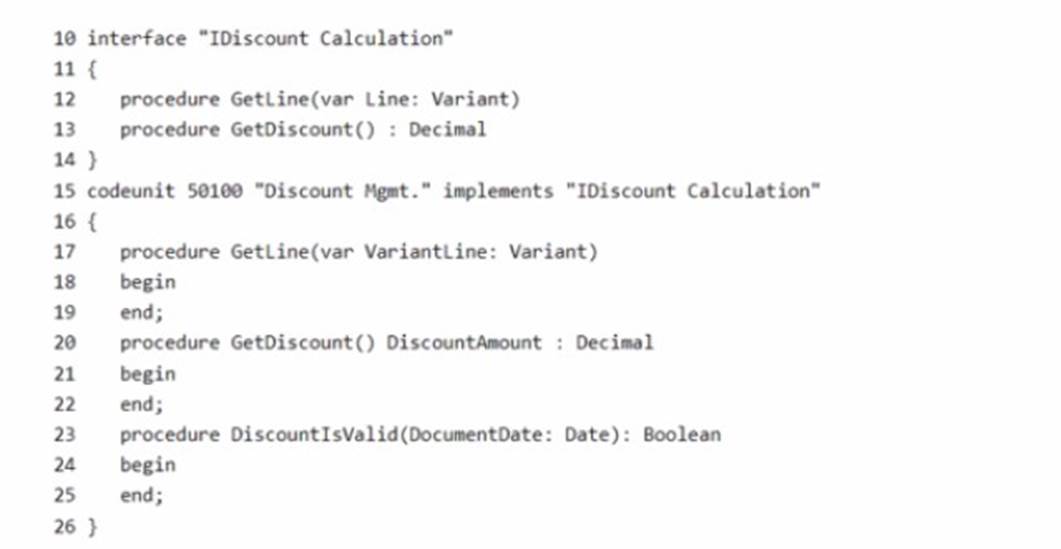- (Topic 4)
Note: This question is part of a series of questions that present the same scenario. Each question in the series contains a unique solution that might meet the stated goals. Some question sets might have more than one correct solution, while others might not have a correct solution.
After you answer a question in this section, you will NOT be able to return to it. As a result these questions will not appear in the review screen.
A company plans to optimize its permission sets. The company has the following permission sets:
You need to provide the following implementation for a third permission set:
• Create a new Permission Set C that is a composite of Permission Set A and Permission Set B.
• Assign Permission Set C to a user.
You need to ensure that the user has only read access to the Job table. Solution: Set the Excluded Permission Sets property to Permission Set B. Does the solution meet the goal?
Correct Answer:
B
- (Topic 4)
A company has extended Business Central. You plan to submit the extension to AppSource.
You need to ensure that an application meets the technical requirements before submitting it for validation.
Which three actions should you perform? Each correct answer presents a complete solution.
NOTE: Each correct selection is worth one point.
Correct Answer:
BCE
B. Include extension translation files with the submission.
✑ AppSource submissions require that the extension be localized to different languages, and including translation files is part of the requirement.
* C. Ensure the app file is digitally signed.
✑ Digitally signing the app file is a security requirement for AppSource submissions to ensure the integrity and authenticity of the app.
* E. Use data classification on all tables and extension fields.
✑ Microsoft requires that all data, especially personal data, be classified using the data classification feature to comply with GDPR and other data privacy regulations.
- (Topic 4)
You ate creating a test codeumt for a company that uses Business Central. The company requites the following list of choices while posting a sales order:
• Ship
• Invoice
• Ship & Invoice
You must create a test codeunit that automatically selects one of these options. You need to create the test codeunit Which handler should you use?
Correct Answer:
D
✑ StrMenuHandler is used to simulate the selection of an option from a string-based menu, such as the "Ship," "Invoice," or "Ship & Invoice" options when posting a sales order. This handler allows you to programmatically select an option during automated testing.
✑ Other handlers, such as SessionSettingsHandler or SendNotificationHandler, do not simulate the selection of menu choices, which is specifically required in this scenario.
For more details on StrMenuHandler and how it simulates user interaction with menu choices, refer to the Test Handlers in Business Central.
HOTSPOT - (Topic 4)
You have a per tenant extension that contains the following code.
For each of the following statements, select Yes if the statement is true. Otherwise, select No.
NOTE: Each correct selection is worth one point.
Solution:
✑ Codeunit "Discount Mgmt." compiles successfully. = NO
✑ VariantLine in line 17 must be changed to Line and the DiscountAmount removed for the codeunit to compile. = NO
✑ The DiscountIsValid method must be defined in the interface for the code to
compile. = YES
The codeunit "Discount Mgmt." will not compile successfully as is because the DiscountIsValid method is not defined in the "IDiscount Calculation" interface, yet it is being declared in the codeunit which implements this interface. AL requires that all
procedures in the codeunit that implements an interface must be defined in the interface itself.
The VariantLine in line 17 does not need to be changed to Line, nor does the DiscountAmount need to be removed for the codeunit to compile. These are valid declarations in AL and they are correctly implemented in the codeunit. The Variant data type in AL is used to handle various data types and DiscountAmount is a valid return type for a procedure.
For the code to compile successfully, the DiscountIsValid method must be included in the interface because AL enforces that any codeunit implementing an interface must implement all the methods defined in that interface.
Does this meet the goal?
Correct Answer:
A
DRAG DROP - (Topic 4)
You create a codeunit that works with a table named Boxes. You plan to filter the records and then modify them.
You get an error that you do not have permission to work with the Boxes table. You need to assign the Indirect permissions for the Boxes table to the codeunit.
Which four code blocks should you use in sequence to assign the correct permission? To answer, move the appropriate code blocks from the list of code blocks to the answer area and arrange them in the correct order.
Solution:
To assign the indirect permissions for the Boxes table to the codeunit, use the following code blocks in sequence:
✑ TableData
✑ "Boxes" =
✑ Permissions
✑ RIM
Assigning permissions:In Business Central, to assign permissions within a codeunit, you need to specify the table that the permissions apply to, followed by the type of permission. The sequence starts by indicating that we are defining table data permissions (TableData). Then, we specify the table in question ("Boxes" =). After that, we state that we are setting permissions (Permissions). Finally, we assign the RIM permissions, which stands for Read, Insert, and Modify permissions. The Indirect permission allows the codeunit to read, insert, and modify records in the Boxes table indirectly, meaning these operations can be performed by the codeunit when it is called by a user who has direct permissions for these operations.
Does this meet the goal?
Correct Answer:
A